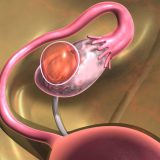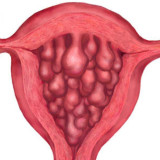A nose sphenoid sinus cyst nose more often appears at the young age. Older people rarely have it. The cavity of the main sinus of the nose is covered with a mucous membrane. The membrane glands secrete the mucus and disruptions in their work leads to the gland ducts clogging. As a result, there appears a sphenoid cyst formation.
The disrupts in the sphenoid mucous membrane are made by the negative impact of inflammatory processes, injuries and allergic reactions.
Sphenoid sinus cyst symptoms
Sphenoid sinus cyst symptoms depend on the localization of the cyst.
The cyst can increase in size and eventually block the sinus cavity of the nose. The cyst can develop due to an inflammatory, allergic process, a true cyst develops due to the blocking of the ducts of the gland secreting mucus. The sphenoid sinus cyst symptoms may not appear pronounced for a long time. But later the patient begins to worry about nasal congestion, headache, pain in the face area, from the affected sinus cyst. Pain can increase when diving, very often develop inflammatory processes in the nose.
In most cases, the disease is asymptomatic. There can be several years between the time when the formation of the disease starts to the first clinical manifestations of the pathology appear. However, patients complain of the following sphenoid sinus cyst symptoms:
rapid deterioration of vision;
the feeling of stretching (pressure) in the sphenoid sinuses of the nose;
nausea, vomiting, dizziness (especially when reading);
headaches with localization in the occipital region.
These sphenoid sinus cyst symptoms can be permanent or appear periodically.
The cyst growing is accompanied by a feeling of bursting in the nose or nausea may occur. There is also headache that refer to the back of the head, rarely develop visual impairment. So feeling that, one better visit the doctor to avoid sphenoid sinus cyst surgery in future.
Headaches twinges are the main symptom of the cystic abnormalities. Special attention to this symptom should be paid by those patients, who have treated neurologist and ophthalmologist diseases with no result. Because the sphenoid sinus cyst symptoms are mainly similar to the nervous system and organs of vision diseases symptoms.
As the cyst grows and increases in size, it makes pressure on the mucous membranes and the bone walls of the sinuses. As a result, the sinus is stretched and there are pathological changes in the sphenoid parts of the nose. It also affects the neighboring anatomical structures like oculomotor and optic nerves, the frontal part of the brain and so on.
Sphenoid cyst removal
If a cyst of the sinus is found, treatment is carried out after a full diagnostic. The doctor prescribes the patient diagnostic tests with using:
- Radiography, that allows to determine the localization of a cysts and monitor the changes in the state of the facial bones or nasal septum.
- Sinus cyst MRI. Magnetic resonance imaging, which determines the state of the skull bones, tissues, vessels. Sinus cyst MRI is more informative diagnostic than radiography.
- Screening with an endoscope allow to observe the nasal cavity, conduct a biopsy of the tissues of the nose.
After the screening is done, there can be assigned the treatment. There is no need for a sphenoid sinus cyst surgery in most cases. At first the doctor prescribes the conservative treatment. It is aimed at analgesia, removal of allergic reactions, inflammation treatment. Then, if the conservative treatment has no effect or the cyst is too large, a sphenoid cyst removal is made with a surgery.
One shouldn’t delay visiting the doctor when feels there can be sphenoid sinus cyst symptoms in order to save the unnoticeable happens of breathing!













